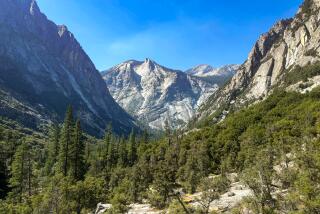Following environmentalist Edward Abbey’s footsteps in the Utah and Arizona deserts

The rock formations and canyons of southern Utah dominate this video, which focuses mostly on Arches National Park. Back when it was a national monument in the 1950s, the park was setting for Edward Abbey’s acclaimed book “Desert Solitaire.” The mos
- Share via
The road trip from Moab, Utah, to Ajo, Ariz., is a sunbaked ramble through about 600 miles of dreamy, lethal desert, beginning with the red rocks of Utah’s Arches National Park, skirting Monument Valley and the Colorado River, and ending in the cactus country of southern Arizona.
I did it in April with one of my favorite writers. Or at least he was when we started.
Edward Abbey (1927-1989) was a desert rat, a chronic contrarian, a serial government employee with a penchant for anarchy.
He made his reputation by exploring Arches in the nonfiction “Desert Solitaire” (1968), then doubled his fame in 1975 with “The Monkey Wrench Gang,” a novel that follows four misfits as they lament lost wild places, burn billboards, disable heavy equipment and dream of liberating the Colorado River from the concrete grip of Glen Canyon Dam. In the wake of that book, a few of his admirers founded Earth First!
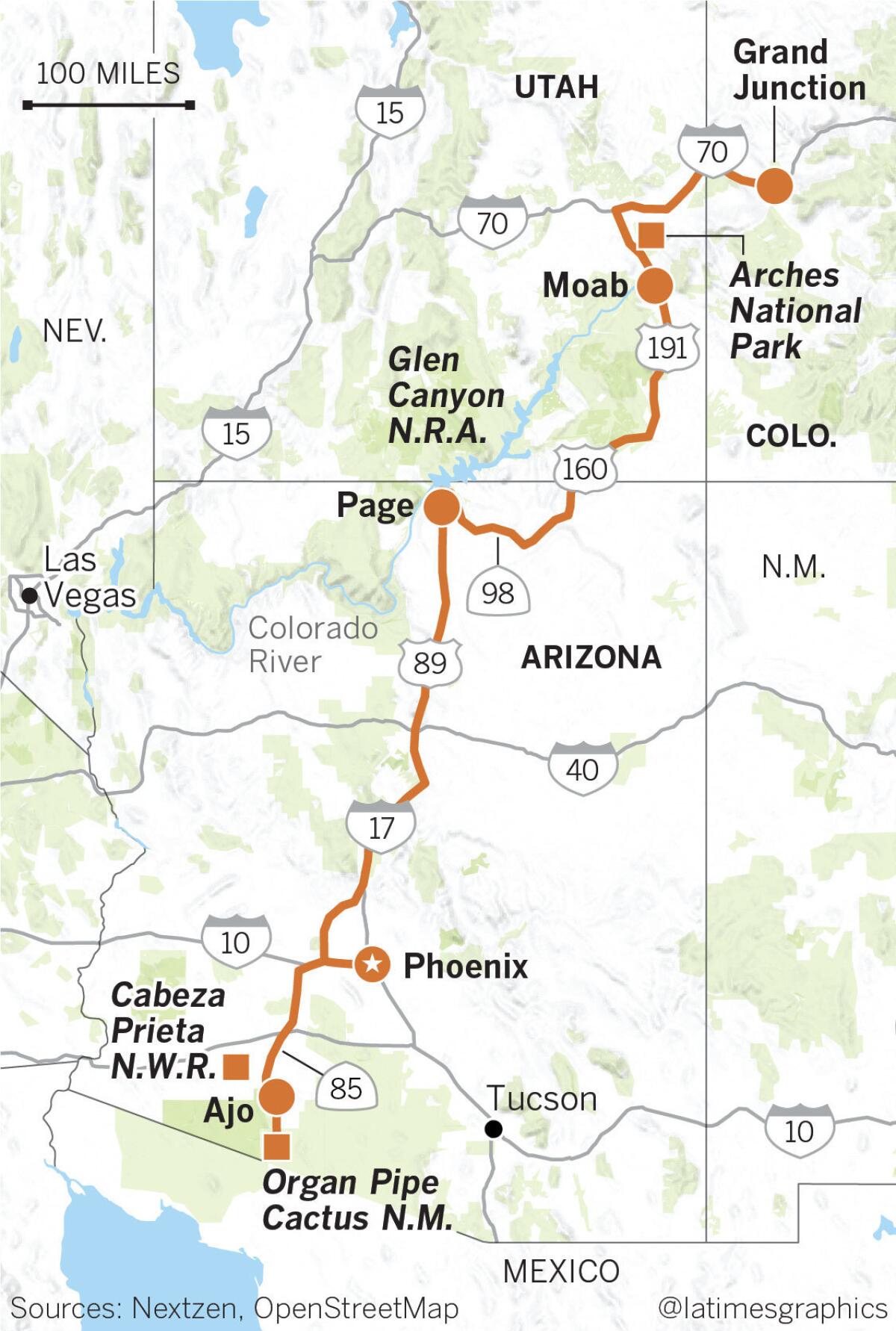
To appreciate the desert, Abbey once wrote, “You can’t see anything from a car; you’ve got to get out of the...contraption and walk, better yet crawl, on hands and knees, over the sandstone and through the thornbush and cactus. When traces of blood begin to mark your trail, you’ll see something, maybe.”
In my 20s I inhaled four or five of his books and met him at a book-signing in La Jolla. I knew nothing about his life off the page, but it seemed to me he spoke for the rocks, the sand and the snakes in a way that no one had.
I recently realized he’d been gone for three decades, and when had I last read him or rambled through his beloved territory? I took a week, flew to Grand Junction, Colo., rented an SUV with all-wheel drive and stocked it with water, snacks and books.
I had three Abbey milestone spots in mind that would make anyone a believer in the desolate beauty of the desert West, even if you never open one of his books.
Hike to Delicate Arch
The first was Arches, where before long I found myself at a trailhead in the dim, blue light before dawn.
Most of the trail was slickrock, strewn with boulders and junipers — “moderately strenuous,” the sign said. In 1½ miles I gained about 480 feet in elevation, tiptoed along a ledge above a big drop, turned a corner and gaped.
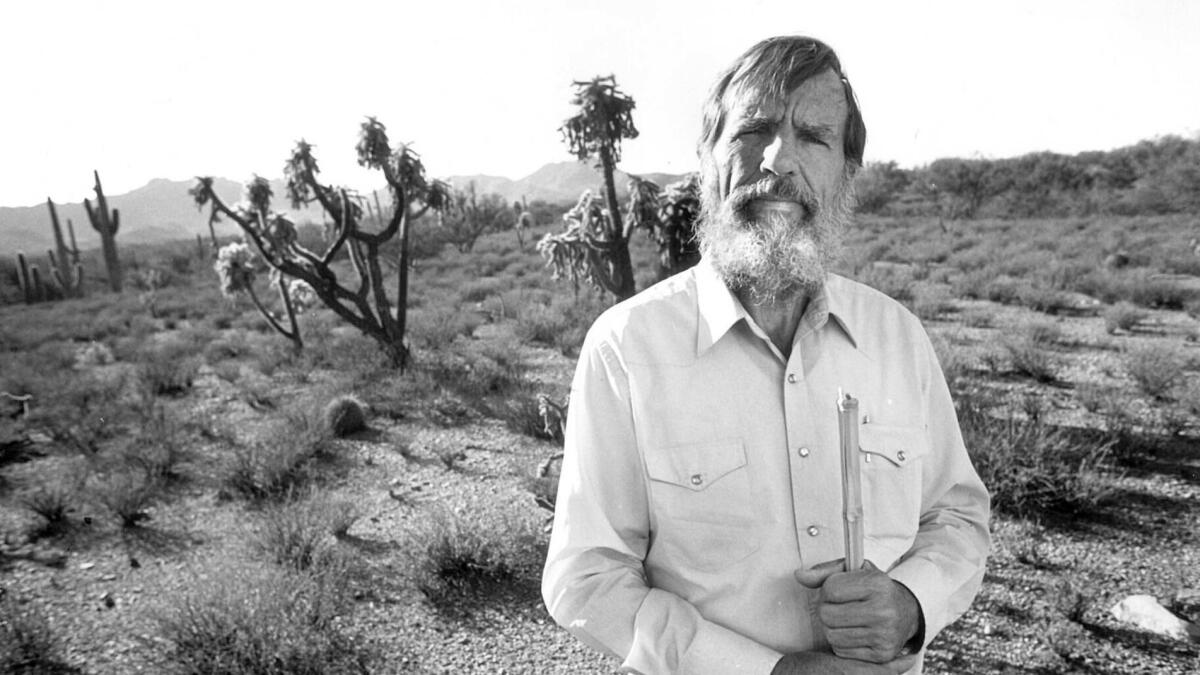
This was Delicate Arch. Among the more than 2,000 natural arches in the park, it’s the marquee attraction, eerily symmetrical, perched on a mountaintop, neighbored by a deep, round bowl of pink sandstone.
Most visitors do this hike in the afternoon, when the light is photo-friendly. But I was willing to trade light for peace, and sure enough, just a few hikers were sprawled about, resting at the foot of the peach-colored arch.

I watched a kangaroo rat sneak up on a puddle. Then I may have dozed off.
After a while I heard a voice in the distance. “Hey,” a man said to someone. “After you get this picture, can you have your kid get off? Because I don’t really want your kid in my picture.”
There were a lot more of us now. I sat up and imagined Abbey, raised in the woods of Appalachia, clambering up here as a 29-year-old philosophy grad student at the University of New Mexico, budding novelist and rookie park ranger.
Still crazy for wildflowers? Colorado road trip leads to the summer bloom »
In those days, about 500 tourists turned up every week in Arches. Abbey answered their questions, collected their trash and lived in a trailer near Balanced Rock, then an outpost, now one of the busiest intersections in the park.
Abbey spent the summers of 1956 and 1957 at Arches, at the time a national monument with no paved roads. Then he spent a decade chewing on the experience and concluded that there should be no pavement at Arches, no more cars in national parks, and no more growth in Western states that don’t have water for it.
Of course, Abbey didn’t get his way. By 1958, paving the main road at Arches had begun. By 1971, Congress had doubled its size and made it a full-fledged park. Now it gets about 32,000 visitors a week.
In Moab, five miles south of Arches, I found a former uranium-mining town decades into a new life as a gateway city for adventure travelers, especially mountain-bikers and off-roaders. Forty hotels have risen, and yet another, the Hoodoo Moab, a Hilton property, is due to open in late summer or fall.
I grabbed dinner at the busy Spoke on Center (order the meat loaf) and found plenty of browsers in Back of Beyond Books. Abbey was everywhere here — novels, nonfiction, postcards, refrigerator magnets. The clerk told me the shop sells one or two copies of “Desert Solitaire” daily, usually to customers in their 20s “or people in their 40s who feel like buying it for their teenage kids.”
Are we recreational vehicle people? Hell, yeah! »
Then she led me to the Abbey-adjacent shelves featuring “Desert Cabal,” a 50th anniversary response to “Desert Solitaire” in which author Amy Irvine takes Abbey down several pegs. Abbey was brilliant, Irvine allowed, but also selfish, sexist and inconsistent.
Over the days that followed, as I headed south, I read in “Edward Abbey: A Life,” by James M. Cahalan, that Abbey married five times, cheated frequently, drank heavily and fathered five children from whom he was often absent. From the ’50s through the ’70s, Abbey served stints in more than a dozen units of the national park system, gigs that took him away from family but gave him time to write and sit at the campfire.
In later years, he taught writing, joined just about every public debate he could find and alienated many allies when he came out against all immigration “until we have brought our own affairs into order.” Between rants about the vulnerability of nature, he occasionally roared around the desert in a fire-engine red 1975 Cadillac Eldorado.
Atop the dam, down the river
I had no Eldorado — my gas-guzzler was a rented SUV — but driving south from Moab was still fun. Open spaces. Throwback signage. Cheap gas (about $2.60 a gallon).
And just when I began to suspect I was driving too fast, a friendly black-and-white sign popped up: SPEED LIMIT 80. I was still legal.

As this video shows, Arizona’s Glen Canyon Dam catches the waters to the Colorado River to make Lake Powell, a vast reservoir in the desert. Below the dam, the river winds through the many twists and turns of Glen Canyon -- including the spectacular
It didn’t take long, roaring down U.S. 191 and 163, to blow past Monticello, Blanding, Bluff and Mexican Hat, then Monument Valley, where I could have passed three days instead of three minutes.
By midafternoon I’d reached the Carl Hayden Visitor Center in Page, Ariz., about 270 miles southwest of Moab, and stepped to the big window. Through it I saw perhaps Abbey’s worst nightmare before me: Glen Canyon Dam, completed in 1963, squatting on the Colorado River ever since.
To grasp what the Bureau of Reclamation did at Glen Canyon, Abbey later wrote, “imagine the Taj Mahal or Chartres Cathedral buried in mud until only the spires remain visible.”
I took the tour — 45 minutes for $5 — which included a stroll along the top of the dam with Paige Spowart, a Glen Canyon Conservancy guide whose command of facts was almost as daunting as all that concrete.
The dam is 710 feet tall, Spowart told us, and sends water and power to several western states. Its reservoir, Lake Powell, accommodates millions of yearly visitors who frolic on houseboats and other watercraft. The lake reached its fullest point in 1983.
Nowadays, after years of hotter, drier weather, the lake is about 62% empty. Vegetation is growing back on land that used to be underwater.
Upstream from the dam, I drove to the Wahweap Overlook for a sunset view of the lake, shimmering like a mirage. Downstream, I hiked to Horseshoe Bend for a sunrise view of the river as it bent 270 degrees beneath 700-foot canyon walls.
Then I climbed aboard a Wilderness River Adventures pontoon boat below the dam. There were 22 of us, along with Jalen Halwood, a savvy guide with Navajo roots and a sly sense of humor.
“If you find yourself on fire,” he said during the safety briefing, “be sure you jump in the water.”
Over three hours, we meandered 15 miles, drifting through Horseshoe Bend, pulling out at Lees Ferry, where Grand Canyon National Park begins. We saw turkey vultures above, fish below, ancient native art at Petroglyph Beach. We drank river-chilled lemonade and dangled toes in the current. Nobody caught fire.
Cue the organ pipes

West of Tuscon, Arizona’s Sonoran Desert is a zone of wide open spaces, towering saguaro, organ pipe cacti, soaring temperatures and sometimes desperate migrants crossing the nearby Mexican border. This video explores Organ Pipe Cactus National Monu
Road trip: In New Mexico, a volcano hike and Wild West history »
By the time I got to Ajo, 38 miles from the Mexican border, I was on the last leg of the trip. Since Page, I’d covered about 370 southbound miles of U.S. 89, interstates 10 and 17 and Arizona 85.
Ajo is the gateway to Organ Pipe Cactus National Monument, a rugged wonderland where Abbey did three seasons as a ranger, and the even lonelier Cabeza Prieta National Wildlife Refuge, where the writer made many expeditions.
He’s still there.
Well before Abbey died of esophageal bleeding at 62, his health deteriorated and he realized his time was short.
He left detailed instructions: His friends should put his body on ice, drive it from his Tucson home to the 860,000 raw-desert acres of Cabeza Prieta and bury him in his old sleeping bag so that he might fertilize a cactus or cliff rose or sagebrush.
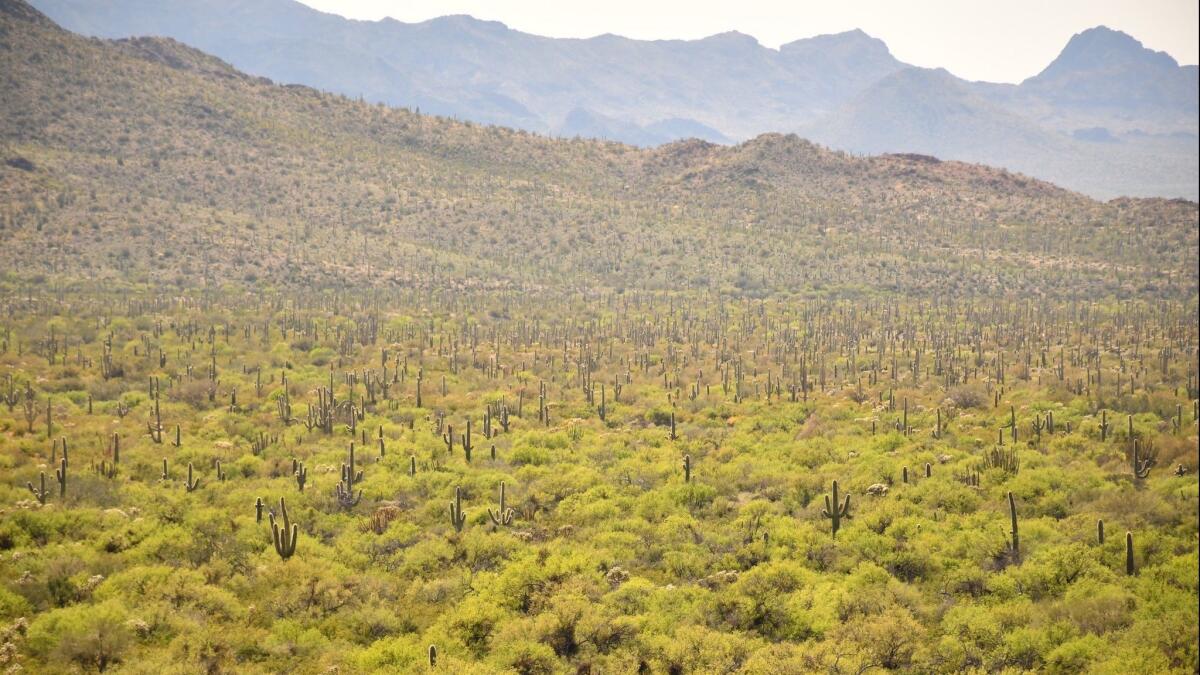
This they did, and marked his resting place with a rock bearing the words NO COMMENT. Since then, many writers and readers have made pilgrimages seeking that spot.
For most of a day, I bounced along Organ Pipe’s unpaved Ajo Mountain Drive and hiked Arch Canyon, where the saguaro and organ pipe are deep green after a wet year. Ocotillos bloomed brilliant red. Palo verde trees blossomed in shrieking yellow. Razor-sharp cholla nipped at my knees, and rabbits ran between the mesquite and agave.
I wouldn’t get near this place in the blast-furnace heat of summer, but this 85-degree spring day was just right. I’d never seen a desert as green and vivid. No other hikers.
It was the same at Cabeza Prieta, with a twist of red tape.
To visit legally, I had to apply online to the U.S. Fish and Wildlife Service for an access permit and promise not to leave anything behind, including food, water or blankets. I signed and found my way to Charlie Bell Road, one of three gravel roads in the refuge.
What I heard: the breeze, the hum of insects buzzing flower to flower.
What I saw: ocotillo, palo verde and cholla, ad infinitum.
When the sun dipped beneath the horizon, the sky went purple and the saguaros and organ pipe cacti turned to soldierly silhouettes.
What I didn’t see: a stone that said NO COMMENT.
Which is just as well. I don’t need to follow Edward Abbey anymore. I’d rather save my admiration for somebody who pays a little more attention to what we owe each other. But I’ll always be grateful that he led me into the desert.
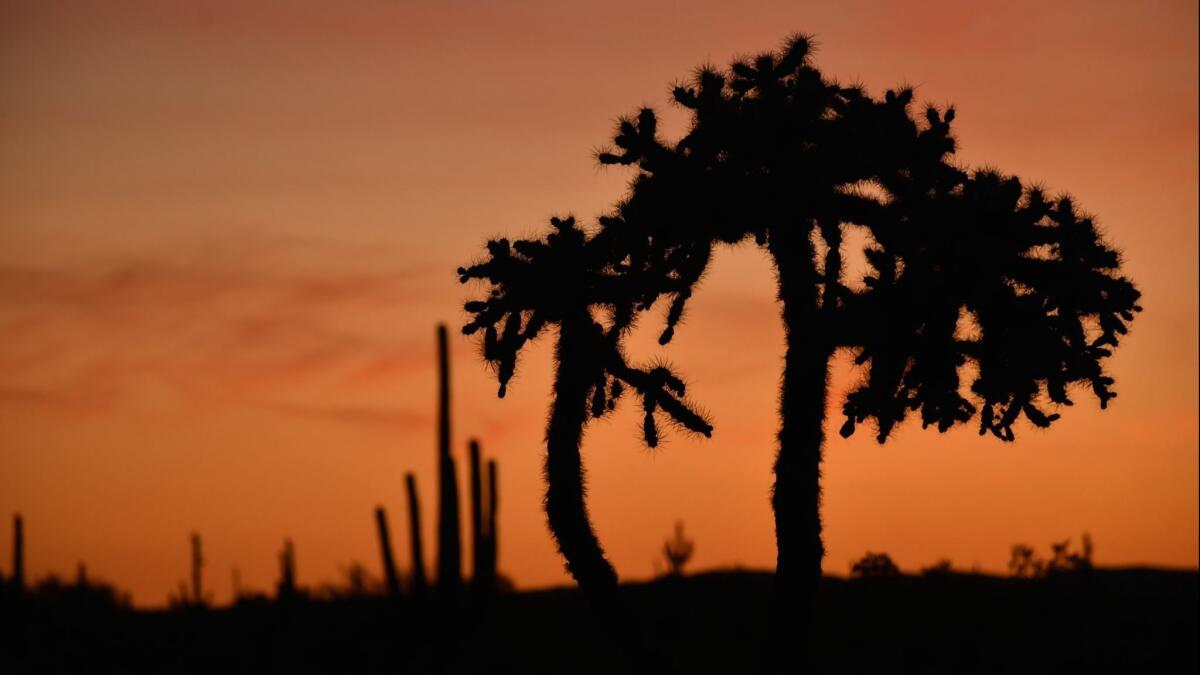
If you go
WHERE TO SLEEP
Gonzo Inn, 100 W. 200 South, Moab, Utah; (800) 791-4044. Doubles from about $209.
Red Rock Motel, 114 8th Ave., Page., Ariz.; (928) 645-0062. Doubles from $80.
Guest House Inn, 700 W. Guest House Road, Ajo, Ariz.; (520) 387-6133, guesthouseinn.biz. Doubles from $89.
WHERE TO EAT
The Spoke on Center, 5 N. Main St., Moab, Utah; (435) 260-7177; thespokemoab.com. Lively, two-level dining room and large patio. Dinner main dishes $11-$18.
Hat Rock Café, Hat Rock Inn, 120 U.S. 163, Mexican Hat, Utah; (435) 683-2270, hatrockinn.com. Breakfast and lunch $8.50-$14.75
Big John’s Texas Barbecue, 153 S. Lake Powell Blvd., Page, Ariz.; (928) 645-3300, bigjohnstexasbbq.com dinner. Big patio with picnic tables. Often live country music. Lunch and dinner. Dinner main dishes $8.25-$23.50
Agave Grill, 1051 Solana Ave., Ajo, Ariz.; (520) 387-4235, agavegrille.com. Mostly burgers and steaks. Dinner main dishes $8.49-$19.99.
TO LEARN MORE
Arches National Park, nps.gov/arch
Glen Canyon National Recreation Area, nps.gov/glca
Organ Pipe Cactus National Monument, nps.gov/orpi
Cabeza Prieta National Wildlife Refuge, fws.gov/refuge/cabeza_prieta
Follow Reynolds on Twitter: @MrCSReynolds
More to Read
Sign up for The Wild
We’ll help you find the best places to hike, bike and run, as well as the perfect silent spots for meditation and yoga.
You may occasionally receive promotional content from the Los Angeles Times.


